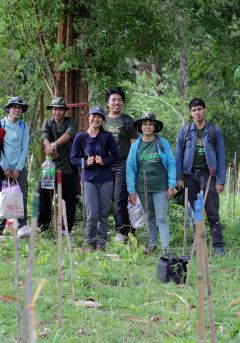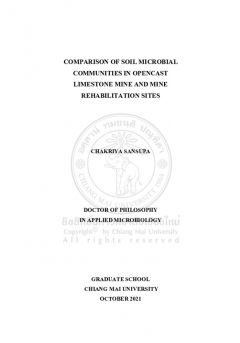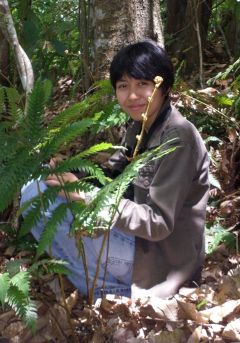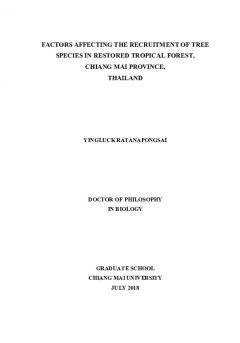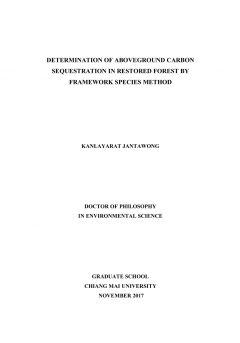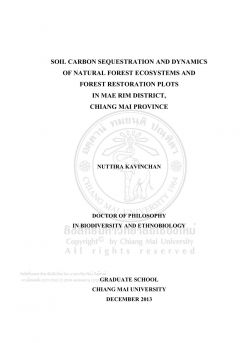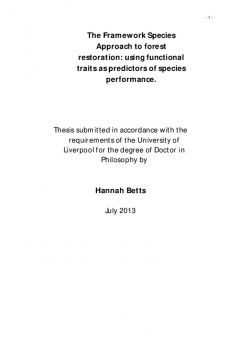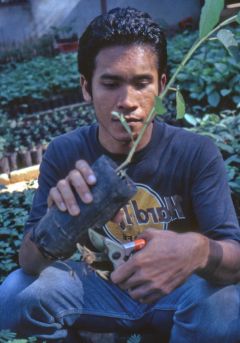Publications
1: Developing Techniques for Direct-seeding for Forest Restoration in Northern Thailand
ABSTRACT: Forest restoration by direct seeding is potentially more cost-effective than tree-planting, especially for upscaling restoration of tropical forest ecosystems. Unfortunately, its success...
2: Comparison of Soil Microbial Communities in Opencast Limestone Mine and Mine Rehabilitation Sites
Opencast mining is considered as an extreme form of land degradation, requiring an intensive array of rehabilitation practices. The mine rehabilitation practice, in the semiopencast limestone mine...
3: New Allometric Equations for Tree Biomass and Carbon Calculations in Secondary Hill Evergreen Forests in Northern Thailand
ABSTRACT: Accelerating deforestation and forest degradation are creating an urgent need for financial incentives, to preserve and regenerate secondary forests, such as carbon-credit trading....
4: Factors Affecting the Recruitment of Tree Species in Restored Tropical Forest, Chiang Mai Province, Thailand
Abstract: FORRU-CMU has been developing and adapting the framework species method of forest restoration (FWS) to restore tropical forest ecosystems to degraded forest land in northern Thailand,...
5: Determination of aboveground carbon sequestration in restored forest by framework species method
ABSTRACT: Tropical deforestation reduces the global terrestrial carbon sink and substantially contributes towards global climate change. Conversely, tropical forest restoration could help to...
6: Development of New Techniques of Seed Storage and Direct Seeding of Native Tree Species for Tropical Forest Restoration
ABSTRACT: Direct seeding (sowing seeds directly into ground) is a low cost method of forest restoration, which could potentially be applied to aerial seeding and replace conventional tree...
7: Limitations to Seedling Regeneration on Tropical Forest Restoration Plantations in Northern Thailand
ABSTRACT: This dissertation investigated potential ecological limitations to seedling regeneration in young, seasonally dry, evergreen forest restoration plantations in northern Thailand. We...
8: Soil carbon sequestration and dynamics of natural forest ecosystems and forest restoration plots in Mae Rim District, Chiang Mai Province
ABSTRACT: The study of below-ground carbon sequestration was conducted in a forest that was restored using framework species method of Forest Restoration Research Unit (FORRU), Ban Mae Sa Mai, Mae...
9: The Framework Species Approach to Forest Restoration: Using Functional Traits as Predictors of Species Performance.
Abstract: Due to forest degradation and loss, the use of ecological restoration techniques has become of particular interest in recent years. One such method is the Framework Species Approach...
10: Reproductive Ecology and Propagation of Fig Trees (Ficus spp.) as Framework Trees for Forest Restoration
ABSTRACT: Fig trees (Ficus spp.) have been promoted as framework species for tropical forest restoration, because they are considered to be keystone species. This study investigated the...
-
- 11: 7
- 12: 6
- 13: 6
- 34: 6
- 10: 3
- 38: 3
- 14: 2
- 36: 2
- 37: 2
- 15: 1
- 16: 1
- 33: 1
-
- 19: 15
-
- 48: 14
- 21: 2

